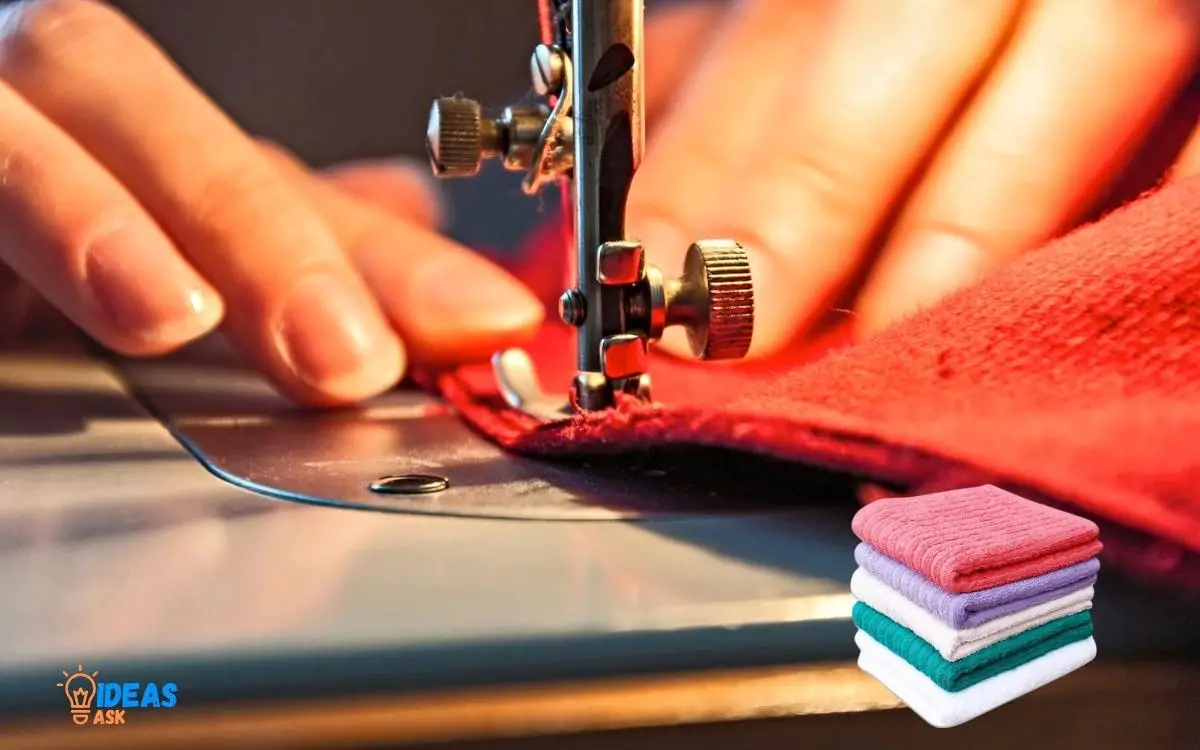How to Make Hand Towels? 5 Easy Steps!
Making hand towels at home is a simple and enjoyable do-it-yourself (DIY) project that anyone can do. All it takes is a piece of fabric, some basic sewing tools, a bit of your time, and a touch of creativity.
Hand towels are essential in any household, used for drying hands or wiping spills. Making your own allows you to add a personal touch to your bathroom or kitchen and saves you money. You can choose the fabric, color, and design to make it unique and match your decor.
While making hand towels at home, it’s a wonderful opportunity to unleash your creativity. You can add embellishments like ribbons, lace, or embroidery to make your hand towels look stylish and unique.
Plus, these homemade hand towels make for thoughtful, personalized gifting options. The joy of making something useful and beautiful by yourself is immensely satisfying. So, grab your sewing tools and get ready to create your own hand towels.
This table presents a simple and basic way to make a hand towel. Other, more complex methods may require additional materials or steps.

Key Takeaway
Step 1: Choosing The Right Materials For Hand Towels
Discover how to select the perfect materials for hand towels, ensuring durability and comfort for everyday use. Find tips on making hand towels that are both functional and stylish.
Fabric Options For Hand Towels:
When it comes to making hand towels, selecting the right fabric is crucial. The fabric you choose can affect the absorbency, durability, and overall quality of the towels.
Here are some fabric options to consider:
- Cotton: 100% cotton fabric is a popular choice for hand towels due to its absorbency and softness. Look for medium to heavyweight cotton fabrics like terrycloth or waffle weave for maximum absorbency.
- Linen: Linen is another excellent choice for hand towels, known for its strength and absorbency. It has a natural antibacterial quality and dries quickly. However, linen hand towels may not be as plush as cotton ones.
- Bamboo: Bamboo fabric is an eco-friendly option that is antimicrobial, hypoallergenic, and absorbent. It offers a silky texture and is highly resistant to odor and mildew.
- Microfiber: Microfiber hand towels are ultra-absorbent and quick-drying. They are perfect for cleaning and are often used in professional settings. However, they may not have the softness of cotton or linen towels.
Choosing the fabric that suits your preference and requirements for hand towels is essential to create the perfect end product. Consider the absorbency, softness, and durability of different fabrics before making your decision.
Selecting The Appropriate Thread For Sewing Hand Towels:
The thread you choose for sewing hand towels can greatly impact the strength, durability, and overall appearance of the finished product.
Here are some factors to consider when selecting the appropriate thread:
- Material: Opt for a high-quality thread made from natural fibers like cotton or linen. These materials are strong and durable, ensuring that your hand towels withstand regular use and washing.
- Weight: Choose a thread weight that matches the fabric weight. For lightweight fabrics like linen or bamboo, use a lighter thread. Medium to heavyweight fabrics require a thicker thread to ensure strong seams.
- Color: Consider the color of the thread and how it complements the fabric of your hand towels. You can either match the thread color to the fabric for a seamless look or choose a contrasting thread color for decorative purposes.
By selecting the right thread for sewing your hand towels, you can ensure that they are not only functional but also visually appealing. Remember to consider the material, weight, and color of the thread to achieve the best results.
Step 2: Measuring And Cutting The Fabric
To create hand towels, start by measuring and cutting the fabric carefully. This step ensures a precise and neat finish for your DIY project.
Determining The Ideal Size For Hand Towels
When it comes to making hand towels, one of the first things you need to consider is the ideal size. Hand towels should be convenient to use while also providing enough space to dry your hands effectively.
Here are some tips to help you determine the perfect size for your hand towels:
- Measure your existing hand towels: If you have hand towels that you find comfortable and functional, measure their dimensions. This will give you a good starting point for determining the ideal size for your homemade hand towels.
- Consider the purpose: Think about where you plan to use the hand towels. Are they intended for a guest bathroom, kitchen, or a personal bathroom? Different areas may require slightly different sizes based on their specific needs.
- Take hand size into account: Consider the average hand size of the individuals who will be using the hand towels. If they have larger hands, you may want to opt for slightly larger towels to ensure sufficient coverage.
- Factor in fabric shrinkage: Keep in mind that some fabrics may shrink after washing. It’s essential to account for this shrinkage when determining the initial size of the fabric.
By considering these factors, you’ll be able to determine the ideal size for your homemade hand towels. Remember to measure twice and cut once to avoid any unnecessary fabric waste.
Tips For Accurate Measuring And Cutting
To ensure precise measurements and clean cuts when making hand towels, here are some helpful tips to follow:
- Use a cutting mat and ruler: Investing in a self-healing cutting mat and a clear acrylic ruler will provide you with a measuring and cutting surface that is both precise and durable. This will help you achieve straight and accurate cuts.
- Mark your fabric correctly: Before cutting the fabric, use fabric-friendly marking tools like tailor’s chalk or washable fabric pens to mark the desired dimensions. This will help you maintain accuracy throughout the cutting process.
- Double-check measurements: It’s crucial to double-check your measurements before making any cuts. Measuring twice will reduce the chances of any errors and ensure that you end up with hand towels of the correct size.
- Use sharp fabric shears: Dull blades can lead to jagged edges and imprecise cuts. Ensure you’re using sharp fabric shears that are suitable for the material you’re working with. This will result in cleaner cuts and overall better-looking hand towels.
- Cut with steady hands: When cutting the fabric, use smooth and steady motions. Rushing or applying excessive pressure may cause the fabric to shift or stretch, leading to inaccurate cuts.
By following these tips, you’ll be well-equipped to measure and cut your fabric accurately, setting the groundwork for beautifully crafted hand towels. Remember to take your time, maintain focus, and enjoy the creative process.
Step 3: Hemming And Sewing The Edges
Discover how to create hand towels with perfectly hemmed and sewn edges, giving them a professional finish. With these step-by-step instructions, you’ll be able to make beautiful and functional hand towels right at home.
When it comes to making hand towels, hemming the edges is an essential step in achieving a neat and professional finish.
In this guide, we will take you through the process of preparing the fabric for the hemming process and provide a step-by-step explanation on how to sew a sturdy hem.
Preparing The Fabric For The Hemming Process
To ensure a clean and polished look for your hand towels, it is important to prepare the fabric correctly before starting the hemming process.
Here’s what you need to do:
- Wash and iron the fabric: Before hemming, make sure to wash and iron the fabric to remove any wrinkles or residual chemicals that may be present. This will help in achieving a smooth finish and prevent any unnecessary puckering.
- Cut the fabric to size: Measure and cut the fabric into the desired size for your hand towels. Remember to leave a little extra for the hemming allowance (about 1/2 inch on each side) to ensure that the edges are fully enclosed.
- Mark the hemming points: Using fabric chalk or a washable fabric marker, mark the points where you will be hemming the edges. This will serve as a guide while sewing and ensure that your hem remains consistent.
Step-By-Step Guide To Sewing A Neat And Sturdy Hem
Now that you have prepared the fabric, let’s dive into the step-by-step process of sewing a neat and sturdy hem for your hand towels:
- Fold the fabric: Start by folding the fabric inwards along the marked hemming point. Ensure that the wrong sides of the fabric are facing each other, and the raw edges are fully enclosed within the fold.
- Pin the hem: Use sewing pins or clips to secure the folded hem in place. This will prevent the fabric from shifting during the sewing process and will give you a clean and even hemline.
- Set up your sewing machine: Thread your sewing machine with a matching thread color and select a straight stitch. Adjust the stitch length to a medium setting to ensure a sturdy hem.
- Sew the hem: Position the fabric under the presser foot of your sewing machine, aligning the folded edge with the needle. Slowly begin sewing along the edge, removing the pins or clips as you go. Ensure that you maintain a straight line and sew all the way around the fabric.
- Backstitch at the end: Once you have completed sewing the hem, backstitch a few stitches to secure the thread. This will prevent the stitches from unraveling and ensure the longevity of your hand towels.
- Trim any loose threads: After sewing, trim any loose threads or excess fabric using a pair of sharp scissors. This will give your hand towels a polished appearance and remove any distractions from the finished product.
By following these step-by-step instructions, you can achieve a neat and sturdy hem for your hand towels.
With a little practice and attention to detail, you’ll be able to create beautiful and professional-looking towels that will impress everyone.
Step 4: Adding Decorative Elements
To enhance the appeal of hand towels, consider adding decorative elements like embroidery, lace trim, or colorful patterns.
This simple DIY technique will elevate the look and add a personal touch to your towels. Enjoy creating your own unique designs!
Designing your own hand towels can be a fun and creative way to add a personal touch to your bathroom. By incorporating decorative elements, you can bring a unique flair to your hand towels and make them stand out.
In this section, we will explore ideas for personalizing hand towels and techniques for adding embroidery or applique.
Ideas For Personalizing Hand Towels:
- Monogramming: Add an elegant touch to your hand towels by monogramming them with your initials or even your family’s initials. This classic and timeless design element will give your towels a sophisticated look.
- Hand-painted designs: Unleash your artistic side by hand-painting unique designs on your hand towels. From floral patterns to abstract art, there are endless possibilities for creating one-of-a-kind towels that reflect your personal style.
- Fabric dyeing: Transform plain white hand towels into vibrant and colorful creations by using fabric dyes. Experiment with different dyeing techniques such as tie-dye, ombre, or even stenciling to achieve stunning results.
- Stamping: Give your hand towels a unique pattern by stamping them with fabric-safe ink or paint. Choose from a variety of stamps, such as geometric shapes, floral motifs, or even custom-made stamps to create your own design.
Techniques For Adding Embroidery Or Applique:
- Embroidery: Embroidering designs onto your hand towels is a popular and enduring method of adding decorative elements. Use embroidery floss and a needle to create intricate patterns or add personalized messages and names.
- Applique: Add texture and dimension to your hand towels with fabric applique. Cut out shapes, letters, or designs from different fabric pieces and sew them onto the towel using a simple running stitch or a more intricate embroidery stitch.
- Lace trim: Enhance the elegance of your hand towels by attaching delicate lace trim. Choose lace in a color that complements your towels, and sew it along the edges for a romantic and feminine touch.
- Ribbon accents: Incorporate colorful ribbons into your hand towels to give them a playful and festive look. Attach ribbons along the edges, create bows, or weave them through eyelets for added visual interest.
Remember, the key to successful hand towel customization is to let your creativity shine. Experiment with different techniques and materials to create unique and personalized designs that will make your hand towels truly one-of-a-kind.
So grab your supplies, unleash your imagination, and start transforming your hand towels into works of art.
Step 5: Care And Maintenance For Hand Towels
Discover essential tips for caring and maintaining hand towels to ensure their longevity. From proper washing techniques to storing them correctly, these guidelines will help you keep your hand towels clean, fresh, and ready for use.
Hand towels are a vital part of our daily routine, providing us with a convenient way to keep our hands clean and dry.
To ensure that your hand towels stay in the best condition and maintain their effectiveness, it is important to follow proper care and maintenance methods.
In this section, we will explore the appropriate washing and drying techniques, as well as useful tips to extend the lifespan of your hand towels.
Proper Washing And Drying Methods
Taking the right approach when it comes to washing and drying your hand towels can significantly impact their longevity and performance.
Here are some essential methods to keep in mind:
- Separate towel types: Wash hand towels separately from other laundry items, especially clothing items that produce lint. Sorting them into separate loads prevents lint transfer, ensuring the towels remain lint-free.
- Mild detergent: Use a mild detergent to wash your hand towels. Harsh chemicals in stronger detergents can damage the fibers and reduce the softness of the towels over time. Opt for a gentle detergent that won’t be too harsh on the fabric.
- Water temperature: To maintain the quality of your hand towels, wash them in cool or warm water. Excessive heat can weaken the fibers and cause shrinkage or color fading. Refer to the care instructions provided by the manufacturer for specific temperature recommendations.
- Avoid fabric softeners: Although fabric softeners add a pleasant scent and make fabrics feel softer, they can decrease the absorbency of hand towels due to residue buildup. It is best to skip fabric softeners when washing hand towels.
- Gentle drying: Opt for air drying or using a low heat setting in the dryer. Excessive heat may damage the towel fibers and lead to shrinkage. Consider hanging the towels outside for a natural breeze, as sunlight can help remove any lingering odors.
Tips For Extending The Lifespan Of Hand Towels
To maximize the durability and longevity of your hand towels, consider the following strategies:
- Rotate regularly: Encourage rotation among your hand towels to distribute wear and tear evenly. Using the same towel repeatedly can lead to excessive fraying and decreased absorbency.
- Avoid excessive use of bleach: While occasional bleach use is permissible for white towels, excessive exposure can weaken the fibers and cause discoloration. Use bleach sparingly and follow the instructions on the packaging.
- Hang properly: After each use, hang your hand towels to dry completely. This helps prevent the growth of mildew and extends the time between washes.
- Keep away from harsh chemicals: Avoid contact between hand towels and harsh cleaning chemicals as they can deteriorate the fabric. Additionally, ensure that lotions, creams, and other skincare products are fully absorbed before using the towels to prevent staining.
- Do not overload the washing machine: Overcrowding the washing machine can prevent proper agitation and rinsing, resulting in incomplete cleaning. Follow the recommended load capacity to maintain the effectiveness of wash cycles.
By following these proper washing and drying methods, as well as adopting the tips to extend the lifespan of your hand towels, you will enjoy clean, fresh, and long-lasting towels in your home.
Take care of your hand towels, and they will serve you well throughout their lifespan.
Conclusion
Looking to add a personal touch to your bathroom? Making hand towels on your own could be a fun and creative way to customize your space.
By following these easy steps, you can create hand towels that are not only functional but also reflect your unique style.
First, choose your fabric and cut it to the desired size. Next, hem the edges to prevent fraying. Then, consider adding decorative elements such as embroidery, appliques, or trim. Don’t forget to finish off your creation by washing and ironing the towels to give them a polished look.
Whether you’re looking to add a pop of color or incorporate a specific theme, making hand towels allows you to have full control over the design. So why not give it a try and showcase your creativity in your bathroom?
Your guests will surely be impressed with your personalized touch.






